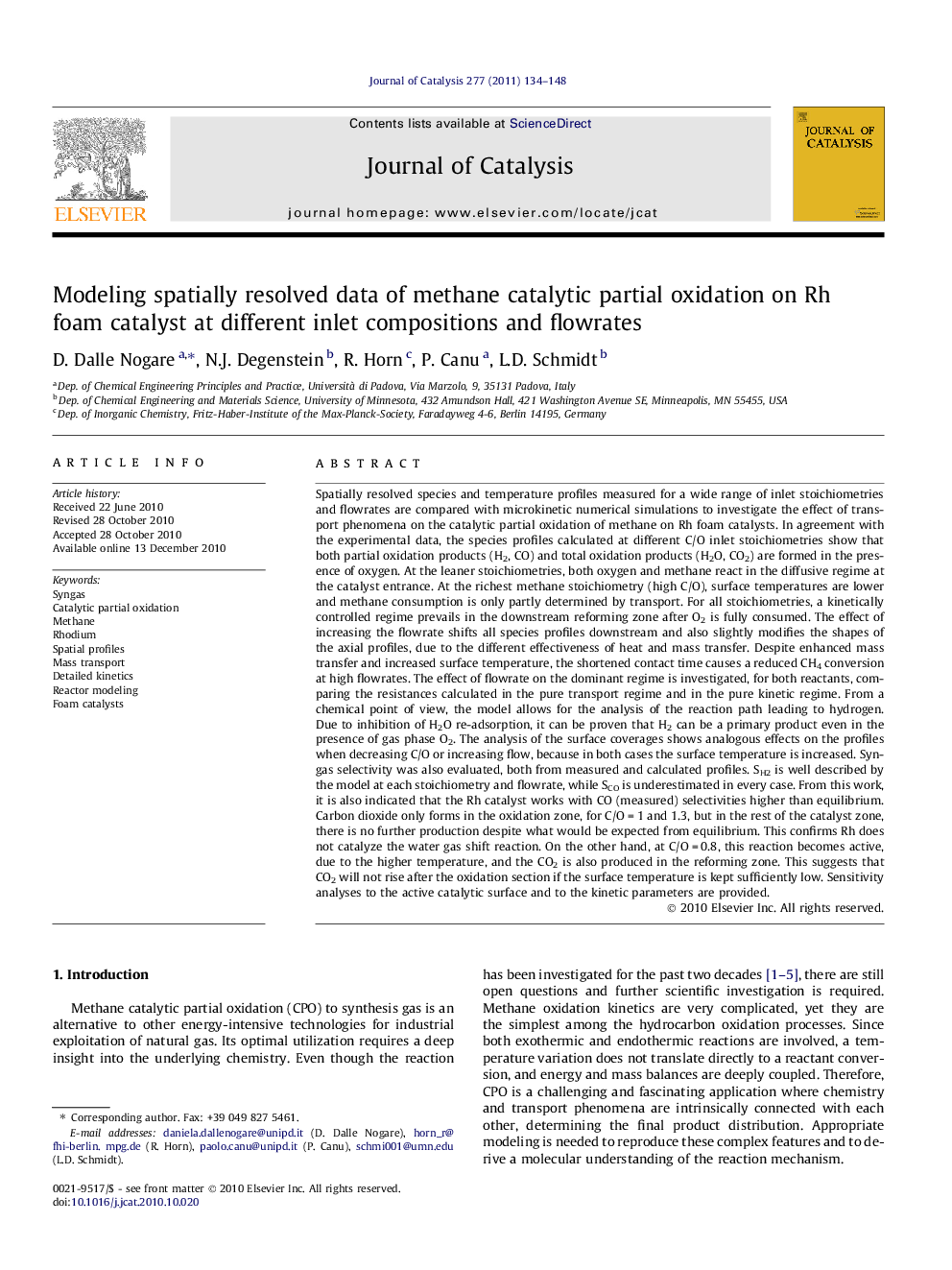| کد مقاله | کد نشریه | سال انتشار | مقاله انگلیسی | نسخه تمام متن |
|---|---|---|---|---|
| 61741 | 47603 | 2011 | 15 صفحه PDF | دانلود رایگان |

Spatially resolved species and temperature profiles measured for a wide range of inlet stoichiometries and flowrates are compared with microkinetic numerical simulations to investigate the effect of transport phenomena on the catalytic partial oxidation of methane on Rh foam catalysts. In agreement with the experimental data, the species profiles calculated at different C/O inlet stoichiometries show that both partial oxidation products (H2, CO) and total oxidation products (H2O, CO2) are formed in the presence of oxygen. At the leaner stoichiometries, both oxygen and methane react in the diffusive regime at the catalyst entrance. At the richest methane stoichiometry (high C/O), surface temperatures are lower and methane consumption is only partly determined by transport. For all stoichiometries, a kinetically controlled regime prevails in the downstream reforming zone after O2 is fully consumed. The effect of increasing the flowrate shifts all species profiles downstream and also slightly modifies the shapes of the axial profiles, due to the different effectiveness of heat and mass transfer. Despite enhanced mass transfer and increased surface temperature, the shortened contact time causes a reduced CH4 conversion at high flowrates. The effect of flowrate on the dominant regime is investigated, for both reactants, comparing the resistances calculated in the pure transport regime and in the pure kinetic regime. From a chemical point of view, the model allows for the analysis of the reaction path leading to hydrogen. Due to inhibition of H2O re-adsorption, it can be proven that H2 can be a primary product even in the presence of gas phase O2. The analysis of the surface coverages shows analogous effects on the profiles when decreasing C/O or increasing flow, because in both cases the surface temperature is increased. Syngas selectivity was also evaluated, both from measured and calculated profiles. SH2 is well described by the model at each stoichiometry and flowrate, while SCO is underestimated in every case. From this work, it is also indicated that the Rh catalyst works with CO (measured) selectivities higher than equilibrium. Carbon dioxide only forms in the oxidation zone, for C/O = 1 and 1.3, but in the rest of the catalyst zone, there is no further production despite what would be expected from equilibrium. This confirms Rh does not catalyze the water gas shift reaction. On the other hand, at C/O = 0.8, this reaction becomes active, due to the higher temperature, and the CO2 is also produced in the reforming zone. This suggests that CO2 will not rise after the oxidation section if the surface temperature is kept sufficiently low. Sensitivity analyses to the active catalytic surface and to the kinetic parameters are provided.
Spatially resolved species and temperature profiles measured for a wide range of inlet stoichiometries and flowrates are compared with microkinetic numerical simulations to investigate the effect of transport phenomena on the catalytic partial oxidation of methane on Rh foam catalysts.CH4+O2=H2+CO+H2OCH4+O2=H2+CO+H2OExperimental (left panel) and calculated (right panel) species profiles at a total inlet flowrate of F = 5 slpm and feed stoichiometries of C/O = 0.8, 1.0 and 1.3 (lighter to darker colors). CH4, O2 and H2, CO, CO2 mole fractions.Figure optionsDownload high-quality image (160 K)Download as PowerPoint slideResearch highlights
► New spatial profiles of CPOM at different C/O ratios and flowrates are available.
► The reactor model includes transport phenomena and a detailed surface chemistry.
► The model reproduces the experimental behavior well, both qualitatively and quantitatively.
► Sensitivity analyses to catalytic area and kinetic parameters are provided.
► Discussions on the dominant reaction regime and on the path to H2 formation have been touched.
Journal: Journal of Catalysis - Volume 277, Issue 2, 24 January 2011, Pages 134–148